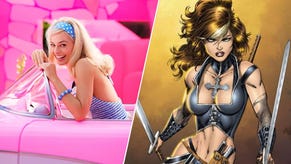Dark Souls 3 review: Miyazaki's triumphant middle ground
Dark Souls 3 balances the strengths and weaknesses of the entire Souls family in director Hidetaka Miyazaki's most balanced vision to date.
While the process around pre-release previews and reviews has been a bit of a mess thanks to the strange circumstances of its weeks-early Japanese release, now is the time: I can finally talk about Dark Souls 3 in detail. Let's get this disclaimer out of the way right at the top: I think that the way this series delivers its narrative is fascinating and a huge part of its charm - so in this piece I'm going to talk about all of Dark Souls 3 in a broad manner that doesn't go into any specific spoiler-filled details.
Dark Souls 3 truly begins to hit a groove not just when the difficulty slides into familiar Souls sadism but also when it begins to offer a more open-ended approach.
Much has been made of the difference in design philosophy between the first and second titles in the Dark Souls series, and with series creator Hidetaka Miyazaki returning to the director's chair for the third, many fans have been curious where Dark Souls 3 will fall on that scale. After completing the game once and getting a good halfway through on a second play through, I'd place it smack-bang in the middle between the two - it's not as open as the first game but not as straightforward as the second, and pretty much everything about Dark Souls 3 is either informed and impacted by this decision or matches up to it - which is why I'm starting off with it.
In an earlier preview I spoke about how Dark Souls 3 tricked me by luring me into a false sense of security with relatively manageable encounters early on before ramping up the difficulty hard once the game finds its stride. That moment when the game truly begins to hit a groove isn't just when the difficulty slides into familiar Souls sadism but also when its areas begin to offer a more open-ended approach.
It's not really possible to walk into a late-game area in the first couple of hours of Dark Souls 3 and realize you're in over your head. The game is designed in such a way that new areas are gate kept fairly well by specific enemies (though no doubt speed runners will quickly sequence break) and thus you likely won't enter a place until you're relatively prepared for it.
This definitely feels like a more accessible Souls game, but none of the challenge has been lost along the way.
The first few areas, the much-previewed High Wall of Lothric and Undead Settlement, are fairly linear. They're big maps but also boil down to point A-to-B, and generally speaking there's two vaguely different routes you can take with back-looping shortcut doors you can open to allow quicker travel from a bonfire to a boss.
The next area up is known as the Road of Sacrifices, and that's where more openness starts to come in. The road ends with swampy woods that have multiple paths out to multiple areas. One of these areas in particular leads players deeper down the game's main narrative, but it's very easy to completely miss one path which leads to a boss and then a whole new area with a boss of its own. If you do miss this particular path the game will much later prod you back towards it in search of a key item, but it's refreshing that there's non-linear options for the order in which you tackle the game's challenges.
Other areas are optional entirely, of course. I've always felt the fake wall was a cheap trick and there's a few of those, but some areas are hidden in much cleverer ways that I won't spoil here. Each serves some small purpose or another to the narrative or to your character progression, offering up loot that can be used or traded with key NPCs at your hub, who it should be noted can also be easily missed since you rescue them from out in the world. Trading in special loot will open up new items in shops or allow you to learn more in fields like pyromancy or sorcery. Tiers of weapon upgrades are also locked behind easy to miss key items that must be handed to the blacksmith, so exploring these non-linear environments is rewarding.
Mechanics such as weapon upgrading are where some of Dark Souls 3's streamlining is more obvious. There's a lot of armour sets, but they can't be augmented and simply scale with your character. Weapon reinforcements are back, but helpfully remain even if you later infuse your weapon with a different element, making it easier to chop-and-change (say to turn a fire sword into a poison sword) without losing loads of power. Weapon durability is generally less of a worry, but in place of this the game also has the new FP meter and weapon art mechanic for you to carefully manage between bonfire refreshes.
On many levels this definitely feels like a more accessible Souls game, but none of the challenge has been lost along the way. Systems have been pruned back in some areas and expanded in others, but the core of it, the combat, is as challenging, responsive and fun as ever. On my first play-through I was a hardy sword-and-shield type in hefty armour, while the second time around I took on a Pyromancer who was far less durable but also able to dish out some truly massive damage with magic.
The shadow of Bloodborne was always going to loom over this game, and Dark Souls 3 actually does an admirable job marrying together all aspects of its disparate Souls universes.
These two play styles ended up vastly different for me, with one all about hulking around and absorbing hits into a massive shield and the other far more focused on dashing and dodging. The latter is now a far more viable way to play with the speed movement in this game far quicker than previous titles across the board- a leaf quite obviously taken from Bloodborne's book.
The shadow of Bloodborne was always going to loom over this game, and while it's no doubt going to be a hot topic of conversation among fans post-release, I feel that Dark Souls 3 actually does an admirable job marrying together all aspects of its disparate Souls universe. Within the narrative there appear to be nods to all of Miyazaki's twisted fantasy work going right back to Demon's Souls, with the nods to that and Bloodborne a little subtler given that the rights sit with a different company. There's a real sense of joy in seeing some of the obvious and not-so-obvious call backs, and this game is no doubt going to produce some really rich and fascinating lore explanation and speculation.
A large part of that storytelling comes down to the design and the execution of the world, which remains largely gorgeous and rich in detail throughout even in the face of some rough performance. All of my pre-release time with the game was spent on PlayStation 4 - at first on a debug console with early access to the day-one patch and then later on my own retail machine. I had some fairly rough issues with slowdown, though only on the retail disc.
A several gigabyte patch was delivered to my retail copy before I booted it, but I'm not clear if that was the true day-one patch or not. The slowdown would only occur when running around, forcing the game to stream in new geometry - it thankfully never occurred to a brutal degree in the midst of a fight. I'm hopeful it will be fixed in a patch.
It should be noted also that I haven't been able to get online to see how co-op or invasions perform since the English version servers have been off prior to this publishing date - so if online matters to you, be sure to check in on how that performs post-launch before buying.
The lack of early access to online did lead to some frustration as I wish I could've summoned help for some of the bosses, which as you'd expect are a major highlight of the experience. Some I'd describe as fun and challenging, some I'd describe as frustrating bullshit, and some I'd describe as a wonderful spectacle but not that much of a challenge. These three categories are the ones I'd also have used for every previous Souls title. It fits the series, and Dark Souls 3 has some of my favourite bosses of the Souls world for reasons of both gameplay and lore.
'It fits the series.' That's the theme. Dark Souls 3 isn't the most original Souls title, nor the most challenging. It's not the quickest or the slowest, and it's neither the most open or linear. Everything about it feels to be a balance of everything that came before. That might leave some people liking it less than their favourite of its predecessors, but it also feels a solid balance that should leave few complaining that it went too far in one direction or another.
In this one can see why Miyazaki has repeatedly described Dark Souls 3 as the final outing for Souls in its current form; in places this feels like his greatest hits package. There's plenty new and memorable on offer, but this title is also absolutely happy to remind you of the glories past with a wink and a nudge. It's meant to be the ultimate Souls experience, a solid blend of everything that came before, and in that it succeeds. It's not breaking new ground, but it'll certainly scratch the itch many have been feeling since the release of whatever their last favourite Souls was, as it has a little piece of all of them.
Dark Souls 3 launches next week for PC, PS4 and Xbox One.















